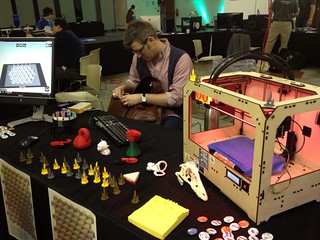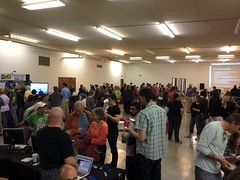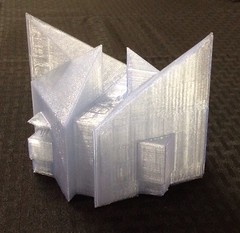Adding to the plethora of 3D printers now available, here come the 3D scanners! Makerbot has announced one, and here’s an IndieGoGo crowdsourcing project for one.
On Feb 14, I got an intriguing email from Brian Matthews about a special edition of the Journal of Library Administration he was editing. It was a request for a chapter for an edition of the journal called Imagining the Future of Libraries, and the Brian’s pitch to me was enough to make me very interested:
[Brian]I’d love for you to contribute an essay around the topic of technology. Beyond most digital collections. Beyond everyone and everything mobile— what unfolds then?
I mean, if I have a specialty, this is it. I love nothing more than I love a good dose of futurism, and told him so. My one concern was the Journal’s publisher, Taylor & Francis, and the fact that I refuse to sign over my copyright on work I create. I’m happy to license it in any number of ways that gives the publisher the rights they need to distribute the work, but I won’t write something for someone else to own. From my reply email to him:
[Me]…there are definitely some details that I’d love to know before I commit. Just to check, this is the same Journal of Library Administration that’s published by Routledge/Talor & francis, correct? What is their author agreement like? I’m pretty dedicated to OA, and wouldn’t be willing to agree to any publication restrictions beyond something like a very short exclusivity clause.
Brian replied with a link he found to Taylor & Francis’ author agreement, which I read…and then responded, a bit more pointedly:
[me] I’ll be blunt: there is no situation in which I’d sign copyright over the T&F…or, frankly, anyone. I’m very happy to sign a license of limited exclusivity (say, 30-90 days) for publication, or license the work generally under a CC license and give T&F a specific exemption on NC so they can publish it. But their language about “Our belief is that the assignment of copyright in an article by the author to us or to the proprietor of a journal on whose behalf we publish remains the best course of action for proprietor and author alike, as assignment allows Taylor & Francis, without ambiguity, to assure the integrity of the Version of Scholarly Record, founded on rigorous and independent peer review. ” is just…well, bollocks.
I am very interested in the topic, and I’ve got a ton to say about it…would love to write it. But we’d have to work out the copyright issue.
Brian’s response from a week or so later indicated that the combination of speed of production (the deadline for the chapters was May 1) and the lack of communication from Taylor and Francis meant this wasn’t going to work out for me to be involved. I was bummed, but totally understood and let him know that I’d love to work on something else with him when the stakes were different.
Our conversation lasted just a couple of weeks, from Feb 14 to Mar 1. Imagine my surprise today when I saw a tweet from Meredith Farkas that said the editorial board of the Journal of Library Administration just resigned because of T&F practices.
Wow! Did the entire Journal of Library Administration editorial board just resign over Taylor & Francis’ practices? Mad props to them!
— Meredith Farkas (@librarianmer) March 23, 2013
Turns out that Brian himself seemingly broke the news in a blog post. From that post:
“A large and growing number of current and potential authors to JLA have pushed back on the licensing terms included in the Taylor & Francis author agreement. Several authors have refused to publish with the journal under the current licensing terms.”
“Authors find the author agreement unclear and too restrictive and have repeatedly requested some form of Creative Commons license in its place.”
“After much discussion, the only alternative presented by Taylor & Francis tied a less restrictive license to a $2995 per article fee to be paid by the author. As you know, this is not a viable licensing option for authors from the LIS community who are generally not conducting research under large grants.”
“Thus, the Board came to the conclusion that it is not possible to produce a quality journal under the current licensing terms offered by Taylor & Francis and chose to collectively resign.”
Between this, and Chris Bourg’s blog post about this event, it sounds like the editorial board had been working for some time to convince T&F of how much they needed to change their expectations for author licensing. Since their requests seemingly fell on deaf ears, they took the only step really offered them, and withdrew from their positions.
I applaud them this decision. I fully understand that I speak from a position of privilege, as I have the ability to turn down writing opportunities such as this without it effecting my career negatively, and that what I’m about to say is said from this same position, but: No scholar should be producing work, whether that work be the creation of content, editing of content, or other, for entities which insist that they are doing you a favor by taking away your rights or the rights of those you represent. I could not in good conscience write a piece that I would have very much enjoyed writing for a publisher that was intent on depriving me of my ownership of that selfsame work. And I am incredibly pleased that the editorial board came to that same conclusion, and that they could no longer support said deprivation.
Brian: if you would still like my participation in that collection, and you find another outlet for it that does respect author’s rights, I’m all ears. To the editorial board, and especially to Damon Jaggers: Bravo! Let us hope that all of you move on to journals that respect the makers of the work they rely on.
Because this post is going to be about people for whom I think you should vote, I will begin with a disclaimer: The opinions below are mine, and mine alone, and I am not speaking in any role other than as an ALA Member with thoughts about the best choices for office.
Now that that little prelude is out of the way, here’s my take on the upcoming elections. These are the people that I think could make a difference in ALA, will make good decisions and guide the organization well, and are the most likely to leave the thing better than when they started. I also think that they represent the best parts of libraries and librarians, and would be positive role models for this, the professional service aspect of our job.
I don’t have opinions on every election outcome, because boy-o there’s a lot of them. But the few that I do care about, here’s who I will be voting for, and who I recommend you vote for as well.
ALA President
Always a big decision, but not always such an exciting set of candidates. This time around, I am thrilled beyond telling that Courtney Young is among the candidates. Courtney is smart as a whip, understands the issues, and will bring a new perspective to the office that gets me excited to see what she will do. I think Courtney would make an great ALA President. I hope that I get the chance to see her as such.
ALA Council
The list here is long, as always, but I think that the following are a great set of librarians who I want to empower to help run our organization: Lauren Pressley, Erica Findley, John Jackson, Kate Kosturski, Chris Kyauk, Coral Sheldon-Hess, and Patrick Sweeney. There are probably more that I’m forgetting, but I’ll add them as I find them on my ballot. 🙂
EDIT: Additional Council candidates that I would recommend: Loida Garcia-Febo, Kevin Reynolds, Edward Sanchez.
LITA Board of Directors
Oh, this is tough. The LITA board slate (Andromeda Yelton, Jason Battles, Brett Bonfield, and Jennifer Reiswig) is an amazing group of people. There are, truly, no bad choices in that field, and I think that’s great for LITA. You can’t go wrong. Me? I’m going to be voting for Andromeda and Brett, for a ton of reasons, but mainly because I think the two of them bring interesting perspectives to LITA that could broaden its horizons in ways that are needed.
So there’s my thoughts on the ALA elections. Democracy in action, people! Make sure you vote!
Not much to say about this, just another step.
Defense Distributed gets license to make and sell 3D printed guns | The Verge.
Chattanooga Maker Day 2013
 This past Saturday, I and Bo Baker represented the UTC Library by taking part in the 2013 Chattanooga Maker Day. Held on the 4th Floor of the Chattanooga Public Library, this event was the first in what I hope to be many examples of the awesome tech potential and talent found in Chattanooga.
This past Saturday, I and Bo Baker represented the UTC Library by taking part in the 2013 Chattanooga Maker Day. Held on the 4th Floor of the Chattanooga Public Library, this event was the first in what I hope to be many examples of the awesome tech potential and talent found in Chattanooga.
 The theme of the day was a “3D Throwdown”, with Makers bringing their 3D printers and printed objects, setting up demos of 3D design, local businesses that were related to 3D technology doing demos and answering questions…it was like a mini-Maker Faire just for 3D printing. And the turnout of people was incredible. From 11am until 4pm when we closed up, it was a non-stop parade of people, kids and parents and grandparents, all who came out to ask questions and see how this tech works.
The theme of the day was a “3D Throwdown”, with Makers bringing their 3D printers and printed objects, setting up demos of 3D design, local businesses that were related to 3D technology doing demos and answering questions…it was like a mini-Maker Faire just for 3D printing. And the turnout of people was incredible. From 11am until 4pm when we closed up, it was a non-stop parade of people, kids and parents and grandparents, all who came out to ask questions and see how this tech works.
I will say, from my perspective, the most amazing moments at the event were the kids who were just wide-eyed at the objects these printers could create. The printers themselves whirring and beeping and generally sounding like droids from Star Wars made the kids aware of a part of their future they didn’t know existed, and it was incredible to see their mind light up with the possibilities.
As far as MPOW, we had dozens of UTC students come through, all of them with the same two exclamations on their lips. First was “You guys are from _the Library_?” and second “The Library is gonna have _this_ for us to use? NO WAY!”. It was a great way to show off the direction that the library is taking, moving into the creative spaces that are so ripe and ready to bloom. We’re still 9 months from opening the new building, but I’m so excited about what that space is going to enable us to do with and for our patrons.
 But Maker Day was about more than just our patrons. It was about showing people the potential of Chattanooga in this new manufacturing space. It was about showing them the building blocks for the future of the community. Chattanooga has The Gig, it has incredibly talented people, and it has a chance to be one of the great technology hubs of the United States. We just have to put all the pieces together the right way, and the groups that put on Maker Day (the Public Library, Co.Lab, and many others) are printing those pieces of our future.
But Maker Day was about more than just our patrons. It was about showing people the potential of Chattanooga in this new manufacturing space. It was about showing them the building blocks for the future of the community. Chattanooga has The Gig, it has incredibly talented people, and it has a chance to be one of the great technology hubs of the United States. We just have to put all the pieces together the right way, and the groups that put on Maker Day (the Public Library, Co.Lab, and many others) are printing those pieces of our future.
In a recent article on Wired, Joi Ito (director of the MIT Media Lab) outlined 9 rules for businesses dealing with the future that technology is bringing to us all. I think these apply to organizations of all sorts, and aren’t a bad starting place for understanding how a modern organization should behave.
- Resilience instead of strength, which means you want to yield and allow failure and you bounce back instead of trying to resist failure.
- You pull instead of push. That means you pull the resources from the network as you need them, as opposed to centrally stocking them and controlling them.
- You want to take risk instead of focusing on safety.
- You want to focus on the system instead of objects.
- You want to have good compasses not maps.
- You want to work on practice instead of theory. Because sometimes you don’t know why it works, but what is important is that it is working, not that you have some theory around it.
- It disobedience instead of compliance. You don’t get a Nobel Prize for doing what you are told. Too much of school is about obedience, we should really be celebrating disobedience.
- It’s the crowd instead of experts.
- It’s a focus on learning instead of education.
I think there’s a lot of potential here for libraries to learn from, but #2 and #4 seem to speak directly to us. My personal favorite is #7, but that’s probably not a surprise to anyone who knows me.
Gigabot 3D Printing
Oxford Performance Materials (OPM) out of South Windsor, CT has announced that it has received FDA 510(k) clearance for its new OsteoFab 3D printed cranial device. This marks the first approval for an additively manufactured polymer implant. The new OPM device is a cranial maxillo-facial (CMF) plate for skull reconstruction which can be used to replace up to 75% of the skull. Their device is made from PEKK (polyetherketoneketone), which has many of the desirable properties of the commonly used PEEK implant material — but it also has twice the compressive strength, making it an ideal material to replace any bone that counts user protection among its primary functions.
via Oxford Performance Materials Now Able to 3D Print 75% New Skulls.
Kinect Fusion pulls depth data that is generated by the Kinect for Windows sensor and, from the sequence of frames, constructs a highly detailed 3-D map of objects or environments. The tool averages readings over hundreds or even thousands of frames to create a rich level of detail.
Its finally happened: a dress has been made using a 3D printer and computers are one step closer to taking over the world. Stagewear designer Michael Schmidt and model Dita Von Teese debuted this 3D printed gown on Monday at the Ace Hotel and it looks very high-tech and cool — a much more wearable take on the partially 3D printed dresses Iris Van Herpen put out for her last collection.
